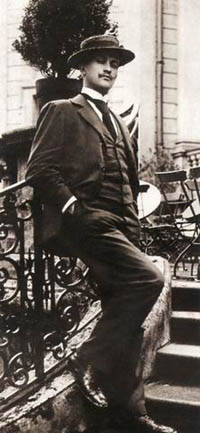
Kotěra left an indelible mark on the history of Czech architecture
 |
A graduate of the Vienna Academy, where he studied under the prominent representative of Austrian secession, Otto Wagner, he endeavored from the outset of his career to ensure that his buildings were functional. However, the fight against the excessive decorative nature of the historicizing architecture of that time was not initially accepted by the contemporary audience, not just the laymen. "Oh come on. Is this the savior from Vienna? It looks like a dog 'licked' it!" architect Josef Hlávka reacted to Kotěra's first realization in Prague, the façade of the Peterka House in the lower part of Wenceslas Square.
The creator, who was not yet 30 years old at the time of completing his first Prague project in 1900, was not deterred by the criticism. That he could demolish entrenched practices was demonstrated when in 1898 he found a professorship at the Prague School of Applied Arts shortly after returning from Vienna. In 1910, he smoothly transitioned to teaching at the newly established special school of architecture at the Academy of Fine Arts. It was there that Jan Kotěra trained an entire new generation of modern architects.
He himself led by example, although he ultimately abandoned the secessionist decorative style only after 1904, when he participated in the Czech Pavilion at the World Exhibition in St. Louis, USA. For instance, the Trmal Villa in Prague's Strašnice (completed in 1902) still contained numerous folkloric elements, including carved railings. However, shortly after that, construction began in Kotěra's atelier that helped usher in modernity in the Czech context, whether it was the water tower in Michle or the architect's own villa in Vinohrady.
In both cases, Jan Kotěra used elements that are also present on his most famous building, the museum in Hradec Králové, completed in 1912. The monumental building on the Elbe embankment was, however, not Kotěra's first construction in the East Bohemian metropolis. Ten years earlier, taking advantage of the opportunities presented by the progressive mayor František Ulrich, he built the District House near the banks of the Elbe in a secessionist spirit. One of the best works from Kotěra's early period now serves as a hotel.
However, Kotěra founded the Hradec Museum on a completely different approach, rightfully making it a symbol of the rising Czech modernism. The two-story building, recently sensitively renovated, features raw brickwork of red-fired bricks, occasionally interrupted by a narrow band of smooth plaster. Jan Kotěra was not only concerned with the building itself, but equally responsibly addressed the urbanistic details of its surroundings. This significantly contributed to the fact that Hradec Králové was often called "the salon of the republic."
The beginning of the 20th century was undoubtedly the happiest period for Kotěra. Before World War I, he designed the façade and interiors of the Palace of the General Pension Institute on Prague's Vltava waterfront (now housing the Office for the Representation of the State in Property Matters) or the Mozarteum department store on Jungmann Street, whose façade recedes floor by floor. The onset of World War I and the architect's deteriorating health, however, caused most of Kotěra's later projects to remain only on paper.
During the war, however, he designed a later realized workers' colony for Zlin's businessman Tomáš Baťa, building on his earlier and smaller solutions in Louny and Záběhlice. Another peak of Kotěra's work was meant to be the new building for Prague's law school, which he had been dealing with since 1907 and which he even won a competition for in 1920. However, the seriously ill Jan Kotěra did not live to see its realization; the project, with a modified interior, was completed by architect Ladislav Machoň, and the law school opened to students at the turn of the 1920s and 1930s.
Jan Kotěra was born on December 18, 1871, in a Czech-German family in Brno, but lived in Bohemia from childhood. He attended German schools in Ústí nad Labem and Pilsen, where he also graduated from a vocational construction school; later, thanks to the support of a descendant of a former noble family, Jan Mladota ze Solopisk, he moved to the Vienna Academy of Fine Arts. For his buildings, Kotěra often designed furniture and other interior furnishings. He was also the author of the design for trams or passenger coaches for the Ringhoffer factory railway.
The English translation is powered by AI tool. Switch to Czech to view the original text source.
0 comments
add comment












